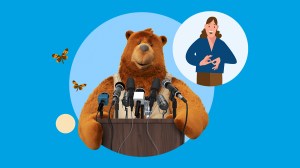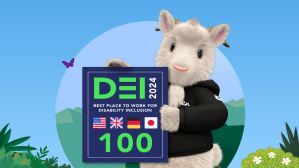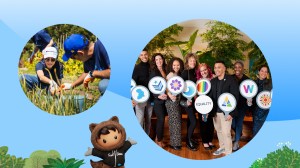Editor’s Note: Over the past few years, more of the world has started to adopt and recognize National Disability Employment Awareness Month. At Salesforce, inclusion is an important part of our workplace culture, so in light of this global adoption, we have decided to honor a more inclusive celebration, simply called ‘Disability Employment Awareness Month.’
October marks Disability Employment Awareness Month (DEAM), recognizing the contributions of people with disabilities, generating awareness, and encouraging improved employment opportunities. This year’s theme is “America’s Recovery: Powered by Inclusion,” a nod to the considerable impact of the pandemic on the disability community.
The pandemic has uncovered many societal inequities. Among the most impacted by recent employment losses are the estimated 1 billion people worldwide currently living with a disability — a growing figure due to aging, and most recently, the long-term effects of COVID-19.
Understanding the disability employment gap
For the disability community, the pandemic has introduced an additional set of challenges such as isolation, exclusion, and a greater lack of equal access to technology. Since the start of the pandemic, the unemployment rate for people with disabilities has increased by 4.5% in the United States alone.
This high employment gap can be blamed on a combination of factors, including false perceptions about the capabilities of workers with disabilities and insufficient investments in disability programs.
“Unfortunately, there can be scenarios where the result of the poor social attitudes and stereotypes can come true if the environment is disabling towards people with disabilities,” said Salesforce Accessibility Support Engineer Darrell Hilliker, who has been blind since birth.
If companies were to invest more in training and recruiting, Salesforce and others believe they’d find that people with disabilities “can ease talent shortages and add to the organizational diversity that drives better decision-making and innovation,” explained Caroline Casey, creator of The Valuable 500, a group working toward greater inclusion in the workforce for the disability community.
Broadening the inclusiveness of a workforce requires much more than simply hiring more diverse candidates. It demands modifications to hiring infrastructure and specific protocols to ensure new employees won’t just survive, but thrive.
Providing inclusive employment opportunities
People with disabilities are critical to an innovative and inclusive culture and deserve an equal opportunity to gain skills for meaningful employment. To do this, Salesforce has created workforce programs designed for people with disabilities in mind.
- Disabilities at Work – Focuses on enhancing manager training, developing mentorship and job coaching programs, and partnering with Recruiting teams on attracting, sourcing, and hiring disability talent.
- Workforce Navigators – Partners with teams across the organization as well as external partners to ensure that our Salesforce Admin Certification process is accessible for people with disabilities.
- Accessibility Partnerships – Works with external partners to help advance the number of Accessibility professionals in the talent pool. Salesforce recently partnered with Atos to grant IAAP certifications for their Accessibility Academy program, which focuses on developing advanced skills in Accessibility with online, classroom, and on-the-job training.
As we look to the future of work, we have a powerful opportunity to do so with Accessibility at the center. The pandemic illuminated for many what had been obvious to people with disabilities for a long time: that the future of work cannot be a one size fits all strategy. Through our Success From Anywhere strategy, we’re providing employees with more flexibility to work where, when, and how they can be most impactful — and encouraging teams to adopt new ways of working that better prioritize balance and wellbeing.
“It starts in our own house, working to become the employer of choice for people with disabilities and attracting and retaining the best talent the world has to offer, in which accessibility plays a critical role,” said Catherine Nichols, VP, Office of Accessibility.
To help make the greatest impact, it is important that we share these insights, programs, and learnings with the wider community. Employers and organizations must work together to make the workplace more accessible and close the unemployment rate gap for people with disabilities.
Working together for a better world
It is our collective responsibility as businesses to create a world where everyone feels safe, valued, respected, and comfortable to bring their authentic self to work. We believe business is the greatest platform for change and are working hard to create opportunities and pathways for the disability community within the walls of Salesforce and beyond.
Over the past year, Salesforce has forged extraordinary relationships with a wide range of nonprofits, agencies, and resource hubs to help close the employment gap for people with disabilities:
- Joined The Valuable 500’s 13 Iconic Leaders, helping to transform businesses with a goal of closing the disability unemployment gap. As an Iconic Leader, Salesforce is working with Mahindra & Mahindra Ltd. and the disability community to research and create innovative ways to provide greater access to job opportunities.
- Partnered with Inclusively, the professional network that is transforming the way candidates with disabilities, mental health conditions, and chronic illness connect to inclusive employers.
- Expanded large-scale partnerships globally by onboarding Business Disability Forum and the International Labour Organization, part of the United Nations — both of which link businesses, governments, and employees to create a disability-smart world of employment.
- Joined digital accessibility resource, database, and community InclusionHub as a founding partner. Launched in December 2020, this first-of-its-kind a11y nexus features crowd-sourced ratings and reviews from a global audience of digital accessibility experts and practitioners, providing an unbiased, transparent, and searchable database of companies that specialize in all aspects of digital inclusion.
We know we have a long way to go, but it’s also important to recognize the hard work of our teams. This year, Salesforce is honored to be named Disability:IN’s 2021 Employer of the Year and receive a score of 100 on the Disability Equality Index — for the third consecutive year. The road to equality, inclusion, and true belonging is a journey but the more we provide people with disabilities access to the same opportunities and experiences, the more inclusive — and stronger — we become.
To follow Salesforce’s accessibility journey, connect with on Twitter at @SalesforceA11y. And to learn about equality initiatives, check out the FY21 Office of Accessibility Annual Stakeholder Impact Report.
Take action
- Consider taking the Disability Equality Index (DEI) survey, if your company doesn’t already do so. The DEI helps companies analyze their environment, identify opportunities, and leverage disability inclusion as a competitive advantage.
- If your company offers self-ID, consider participating. This helps companies ensure they are creating and sustaining a diverse and inclusive workplace as well as shaping policies and benefits to support people with disabilities.
- Learn on Trailhead: Take a trail on Trailhead to learn why it’s important to make technology accessible to everyone and the best practices for authoring accessible content.
- Trailblazer Success Community: Ask questions, discuss workarounds, and collaborate with other users of Assistive Technology. This is a group to discuss all things disability-related. Visit the Community.



















